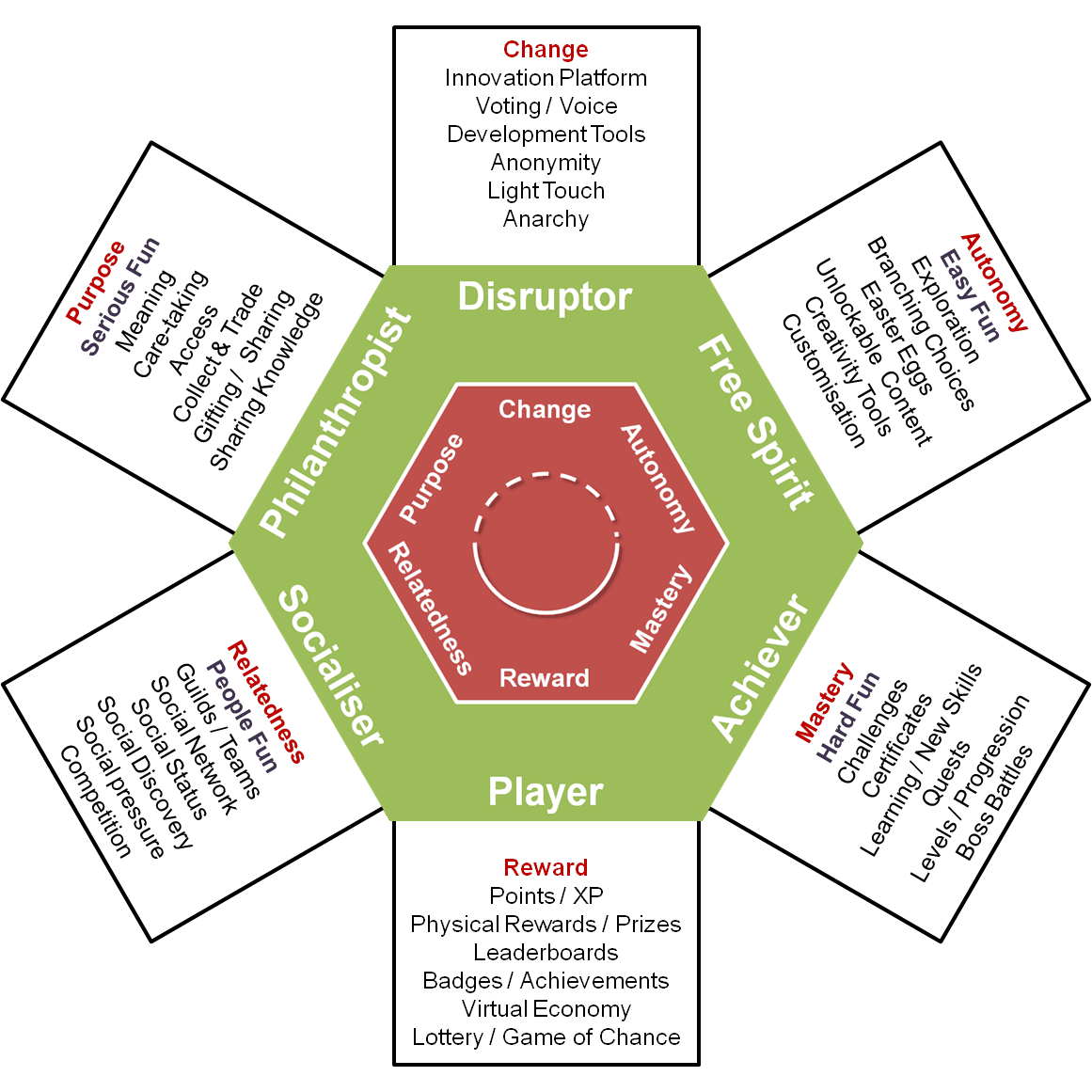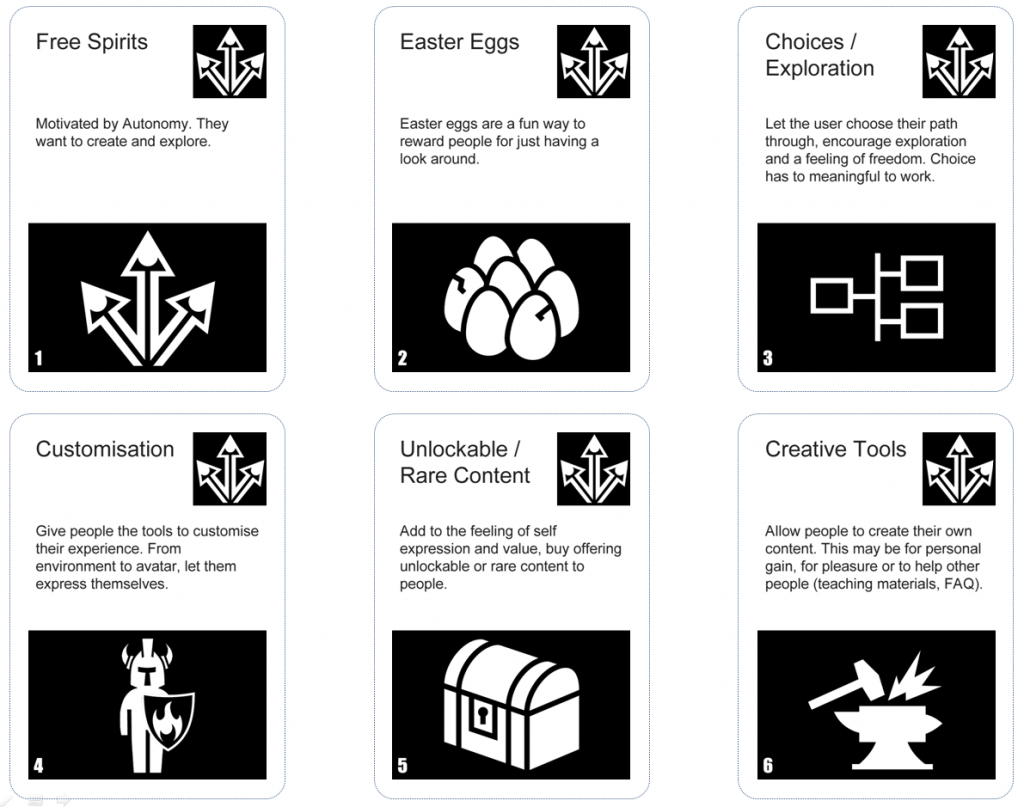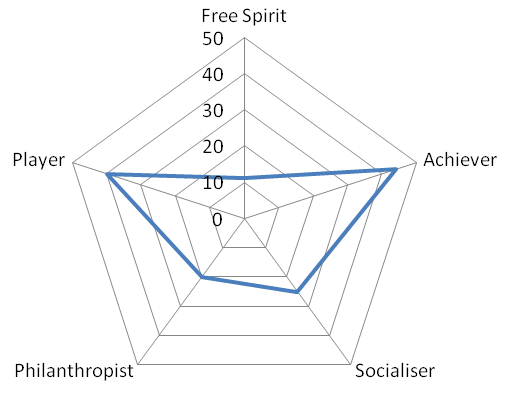Since I first launched my User Types nearly a year ago, I have had lots of great feedback, interesting criticism and a few changes of heart here and there. I have tried to evolve the types and add detail to them, in an attempt to help other people make use of them. The goal was to create a usable framework to help you plan and build gamified systems by identifying a few basic types of users and how to engage them.
Along the way, I seem to have actually made it too complex for many – something than 1.5 tries do deal with (a little). It is also based in part on the stats I have collected from the User Types test that has been running for many months now. So first, some stats.
We all love stats!
There have been 334 responses – not enough to be scientific, but more than most shampoo adverts! You can see all of the raw numbers here.
Of 334, taking into account that some people display multiple “dominant types”, the following types were seen. Mixed is seen as part of multiple dominant types (e.g. Achiever / Socialiser), pure is seen on its own – hence there are more than 334 here!
| Type | Mixed | Pure | Total | % |
| Achiever | 102 | 117 | 219 | 44% |
| Socialiser | 86 | 40 | 126 | 25% |
| Philanthropist | 69 | 32 | 101 | 20% |
| Free Spirit | 41 | 15 | 56 | 11% |
In the test, a 5th metric is looked at – how much influence rewards have on the person taking the test. An average taken of this influence across the 334 tested is 0.4. 135 people who took the test had a reward influence score over this average, that’s 40%! However you look at it, the majority of people see themselves as displaying a dominance in the Achiever type.
If we look at just those users who have an above average reward influence, we see the following.
All Types (mixed and pure together) Influenced by Rewards
| Type | Total | Influenced | % Influenced |
| Achiever | 219 | 120 | 55% |
| Socialiser | 126 | 41 | 33% |
| Philanthropist | 101 | 20 | 20% |
| Free Spirit | 126 | 9 | 1% |
Pure Types
| Type | Total | Influenced | % Influenced |
| Achiever | 117 | 76 | 56% |
| Socialiser | 40 | 10 | 7% |
| Philanthropist | 32 | 0 | 0% |
| Free Spirit | 15 | 1 | 1% |
| Mixed | 130 | 48 | 36% |
As you can see, Achievers (according to this) are the User Type who are most influenced by rewards. Now, when I think about this, it seems quite obvious – once you remove the concept that all rewards have only an extrinsic meaning. This is where my definitions have been causing confusion it seems.
Not all rewards are extrinsic
The lesson here is that not all rewards should be considered only extrinsic, even points and badges. Whilst a user who is an achiever is mostly going to be driven by a desire for Mastery, there is nothing to say that they don’t like getting points and badges. For many they are a fantastic way to measure their achievement and progress. This is not to say they want bragging rights, but that they like to see how they are getting on – the extrinsic reward can have an intrinsic meaning to them.
For now let me conclude by saying, just because I have labelled these my “intrinsic” user types, don’t be drawn into the idea that rewards and the like will not appeal to them. The point is that the intrinsic types will still continue to do what they are motivated to do even without the rewards. That does not mean you should not offer them, especially early on in the process.
Next week, I will be presenting a simplified User Types – v1.5 if you will. It will be based on 6 types. Achiever, Socialiser, Philanthropist, Free Spirit, Player and Disruptor. This will not replace the previous types (9 of them), but it should help make it more usable and easier to understand and implement.
Until then, why not take the user type test and add to the data!
Similar Posts:
- User Types – an expansion to consider
- Relationships Between HEXAD Types
- Using the Gamification User Types in the Real World






Hi Andrzej!
I am a really big fan of your work!
I am a Master student and my work intends to adapt the gamification based on the user type in an educational adaptive system. For this, I would like to implement this test in the system (I’ve already translated it for Portuguese) but I am not sure about the way the calculation is done. Would you mind sharing the formula?
Thank you in advance,
Ana
Hi. Can you email me. [email protected] I have it all in a spreadsheet!
I like your explanation of the connection between intrinsic and extrinsic rewards though I’m struggling with the concept that some players are their just for extrinsic rewards – i.e., the players. I believe all extrinsic rewards are simply a vehicle to enable intrinsic motivators. A badge is just a tangible way to allow the user a sense of accomplishment. Points help them track their progress en route to mastery. Without those items, there would be no end in sight and therefore no opportunity to accept and be proud of progress already made. Even if I’m solely trying to collect as many badges as possible, that’s still an intrinsic motivation for mastery at the game, right?
Granted, an exception would be if those points can be exchanged for real world goods/services in which case that person might be exclusively motivated to earn points for a future purchase.
Hi
The point is that not everyone needs to track progress. I don’t answer questions on quora to get told I’m great or see a reward. I do it because I hope it helps people.
Points and the like are definitely a good marker of progress, yes. However, more commonly they are used as an incentive to perform an action. There is very likely no reason for me to click the like button on an article I have not interest in. However, if I like collecting badges and points – then maybe I will click it to rank up. Yes, there is ultimatly some intrinsic personal reading for that – but the motivation is still coming from this extrinsic means. I’m not clicking the butting because I want to click the button, I’m clicking it because I want the reward. That can be hard to sustain.
Haha, nice work. But with 6 more user-types that does not replace the previous 9, the context does get more complex, even though the goal is to simplify, haha 😉
I’m working on pieces that introduce your player types, but I don’t know where to start now with a limited burst of info 😛
Haha. I knew you would comment. 😉
Ok. Intrinsic types and extrinsic types don’t change. They are still fine. Number 9 is the disruptor – so you can ignore that in your motivations.
The 6 types are the 4 intrinsic, the player (which if you remember is the group name for the extrinsic types when I first defined all of this) and disrupters.
People got confuse over how rewards affect intrinsic types as I say that certain rewards and the like can help support them. The key being that the extrinsic group would stop being involved if you removed rewards, but the intrinsic group would stay regardless.
Sooooooo.
Player in 1.5 represents the users that are there to play for pure extrinsic reasons. They tend to interact with both the users and the system. They will display traits of all the intrinsic types (creating our exploiter, networker, self seeker and consumer types), but be motivated primarily by rewards and extrinsic things. It is almost like a modifier in a game, acting on the other types.
Disrupter types act on users and the system. They just want to destroy – but again may display other traits. Again, a modifier of sorts.
For your purposes, use whichever makes most sense to you. I like the 6 types as it is less black and white – like reality 😉
https://plus.google.com/115172794782992605310/posts/beCwfZZUjG8
Haha – I need to become less predictable! (aka not commenting :P)
Since everyone is motivated by some extrinsic means, I think it is tough to group all extrinsic types into “players.” And also the term “player” is a bit ambiguous, because the word “play” generally means doing things for intrinsic reasons…though if a person is a “player,” it could become extrinsic but not necessarily. Just because a bit more complex.
Also, in motivational science we learn that the best way to get a person to stop doing something intrinsically is to give them money to do it, and then take the money away. In that case, a person can easily be converted from a regular player type into a “player” and get stuck there for a long time.
Finally, random side note: the world Philanthropist is so long and a mouthful. Would it retain the meaning if it is called Altruist? No biggy if it doesn’t, but part of Bartle’s catchiness is each player type is distinct and easy to pull up ;P
So player comes from the original first definitions of my types. They are the group that are willing to play the game you have set up – ie, do things for the rewards you have added. Click like to get a cookie.
As I say, they are a group, but only a group that do the same thing as the intrinsic types – but for cookies. Answer questions like a philanthropist, but for a cookie.
As for the word philanthropist. I looked at altruist, but that tends to be more pasisive. Someone who puts the needs of others before them selves. Philanthropists go out of their way to help others – it is much more active. A great deal of thought went I to that one.
As I said, this is generally about adding grey to the definitions. This makes them more actionable in real life rather than in theory.